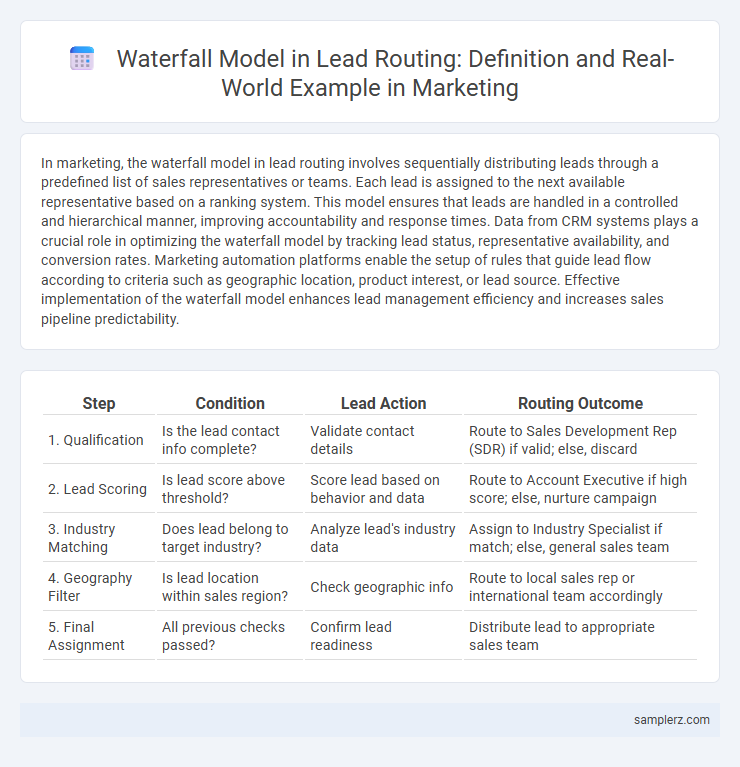In marketing, the waterfall model in lead routing involves sequentially distributing leads through a predefined list of sales representatives or teams. Each lead is assigned to the next available representative based on a ranking system. This model ensures that leads are handled in a controlled and hierarchical manner, improving accountability and response times. Data from CRM systems plays a crucial role in optimizing the waterfall model by tracking lead status, representative availability, and conversion rates. Marketing automation platforms enable the setup of rules that guide lead flow according to criteria such as geographic location, product interest, or lead source. Effective implementation of the waterfall model enhances lead management efficiency and increases sales pipeline predictability.
Table of Comparison
| Step | Condition | Lead Action | Routing Outcome |
|---|---|---|---|
| 1. Qualification | Is the lead contact info complete? | Validate contact details | Route to Sales Development Rep (SDR) if valid; else, discard |
| 2. Lead Scoring | Is lead score above threshold? | Score lead based on behavior and data | Route to Account Executive if high score; else, nurture campaign |
| 3. Industry Matching | Does lead belong to target industry? | Analyze lead's industry data | Assign to Industry Specialist if match; else, general sales team |
| 4. Geography Filter | Is lead location within sales region? | Check geographic info | Route to local sales rep or international team accordingly |
| 5. Final Assignment | All previous checks passed? | Confirm lead readiness | Distribute lead to appropriate sales team |
Introduction to the Waterfall Model in Lead Routing
The waterfall model in lead routing systematically directs leads through a predefined sequence of sales representatives or teams based on specific criteria such as geography, product interest, or lead score. This structured approach ensures efficient lead distribution by assigning each lead to the next available representative only if the previous one is unavailable or unresponsive. By prioritizing lead allocation through this step-by-step process, organizations increase conversion rates and optimize sales pipeline management.
Key Principles of Waterfall Lead Routing
Waterfall lead routing prioritizes sequential lead distribution, sending leads to the highest-priority sales rep first before moving down the hierarchy if unclaimed. Key principles include clear lead qualification criteria, ensuring leads match specific rep expertise or territory, and predefined time thresholds that trigger lead escalation. This model enhances lead accountability, reduces overlap, and maximizes conversion efficiency by systematically managing lead flow.
Step-by-Step Breakdown of the Waterfall Process
The waterfall model in lead routing sequentially assigns incoming leads to sales reps based on a predetermined hierarchy, ensuring systematic follow-up. Step one routes the lead to the primary sales agent; if unresponsive, step two escalates the lead to a secondary agent, followed by subsequent steps until contact is made. This step-by-step method optimizes lead distribution, minimizes response delays, and maximizes conversion rates by maintaining clear accountability.
Real-World Example: Waterfall Lead Routing in Action
In marketing, a waterfall lead routing model sequentially assigns leads to sales representatives based on predefined criteria such as territory, industry, or lead score. For example, in a software company, leads first route to the regional sales rep; if unclaimed within a set timeframe, the lead cascades to a secondary rep with specialized product knowledge. This structured approach optimizes response time, enhances lead coverage, and improves conversion rates by ensuring leads don't go unattended.
Comparing Waterfall with Round-Robin Lead Routing
Waterfall lead routing assigns leads in a prioritized sequence to sales reps, ensuring high-value leads go to the most experienced agents first, increasing conversion rates. In contrast, round-robin distributes leads evenly across the team, promoting workload balance but potentially diluting lead quality focus. Comparing waterfall with round-robin lead routing highlights how structured prioritization boosts efficiency in targeted lead management versus balanced lead distribution.
Advantages of the Waterfall Model for Sales Teams
The Waterfall Model in lead routing sequentially prioritizes sales leads, ensuring each sales representative receives leads only after the previous agent's capacity is met, which streamlines workload distribution. This method increases lead accountability and minimizes overlap, resulting in higher conversion rates for sales teams. By establishing clear stages in lead assignment, the Waterfall Model enhances efficiency and transparency in sales operations.
Addressing Common Challenges in Waterfall Lead Routing
Waterfall lead routing often encounters challenges like lead leakage and delayed responses due to sequential lead assignment, resulting in missed opportunities. Implementing automated failover rules ensures leads unaccepted within specific timeframes are promptly routed to the next representative, reducing bottlenecks. Data analytics tools help monitor lead response times and conversion rates, enabling continuous optimization of the waterfall structure to enhance overall lead flow efficiency.
Optimizing Conversion Rates with Waterfall Lead Distribution
Waterfall lead distribution sequentially routes leads to sales representatives based on predefined criteria, ensuring higher quality leads receive priority attention to optimize conversion rates. By structuring lead flow, this method minimizes lead leakage and improves response times, directly impacting sales performance. Implementing a waterfall model enhances resource allocation and boosts lead engagement by progressively cascading leads until converted.
Best Practices for Implementing Waterfall Lead Routing
Implementing waterfall lead routing requires defining clear lead qualification criteria to ensure leads are assigned to the most suitable sales representatives. Establish tiered response times and escalation protocols to maintain lead engagement and maximize conversion rates. Continuously analyze lead flow metrics and adjust routing rules to optimize team performance and reduce bottlenecks.
Future Trends in Lead Routing: Is Waterfall Still Relevant?
The waterfall model in lead routing, where leads are sequentially passed through predetermined sales stages or representatives, remains a foundational approach in many marketing operations. Future trends suggest a shift towards AI-driven, dynamic lead distribution systems that prioritize real-time analytics and personalized engagement over static routing sequences. Despite this evolution, waterfall models continue to serve as reliable frameworks for companies with structured sales hierarchies and predictable lead qualification criteria.

example of waterfall model in lead routing Infographic
 samplerz.com
samplerz.com